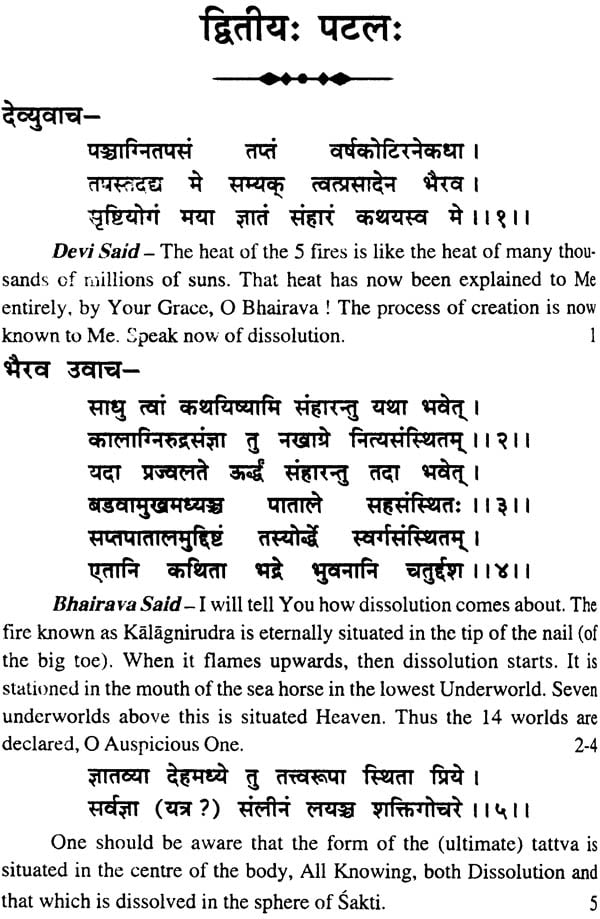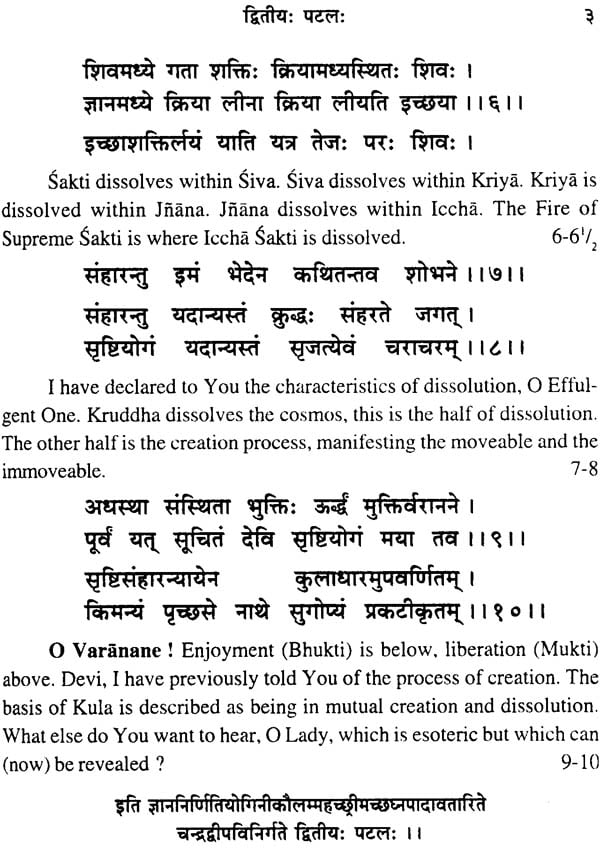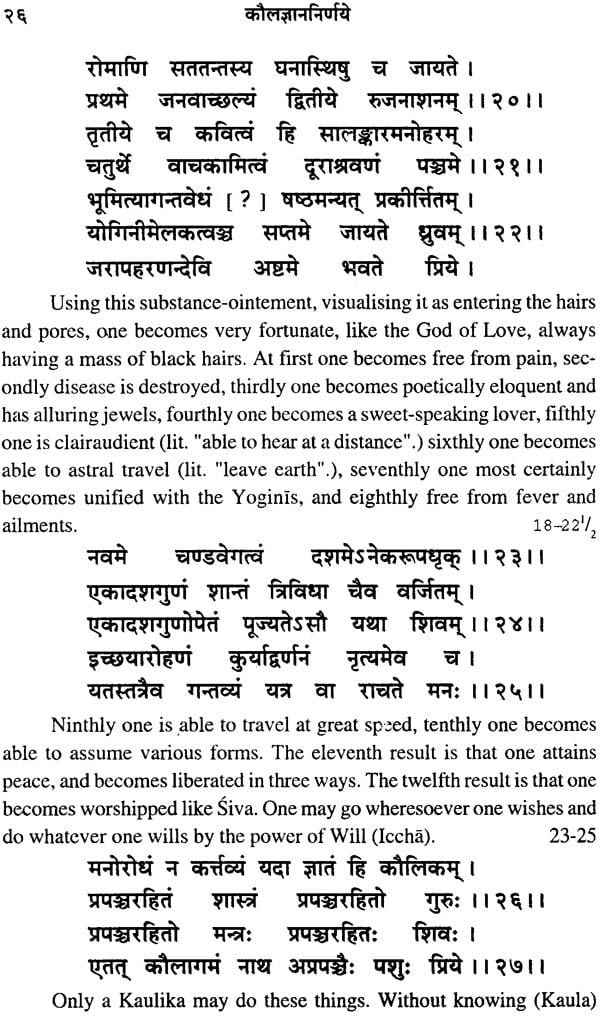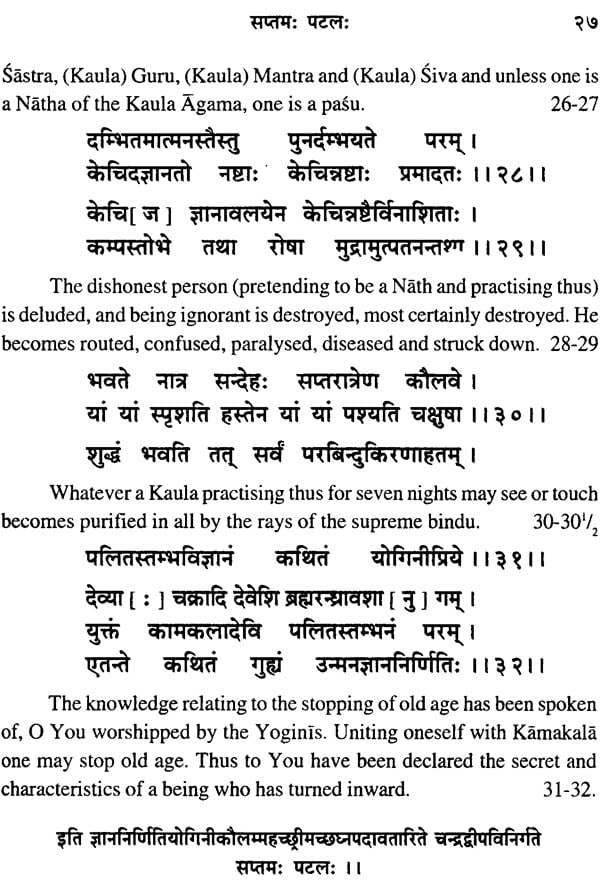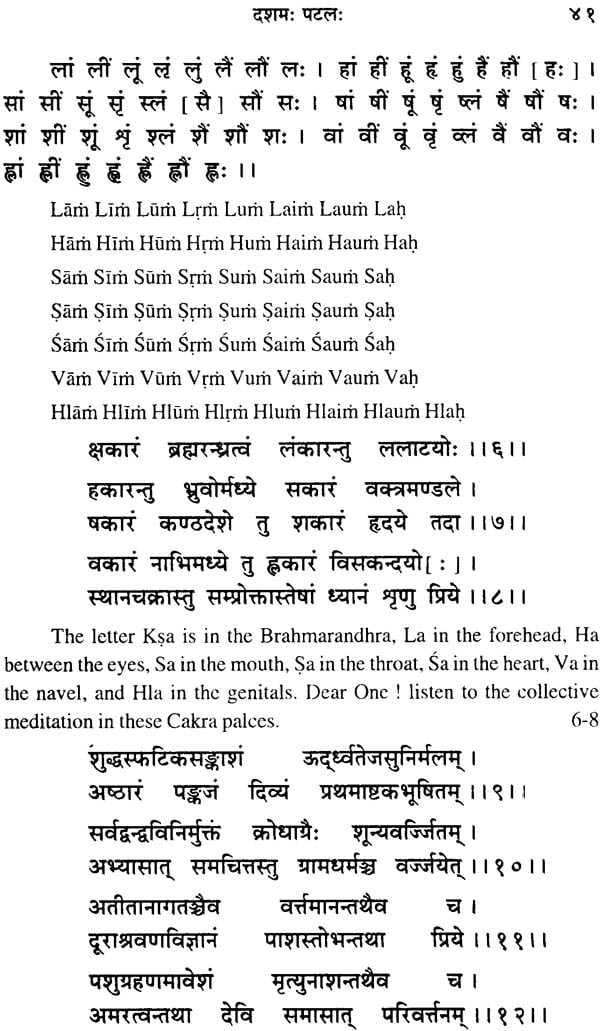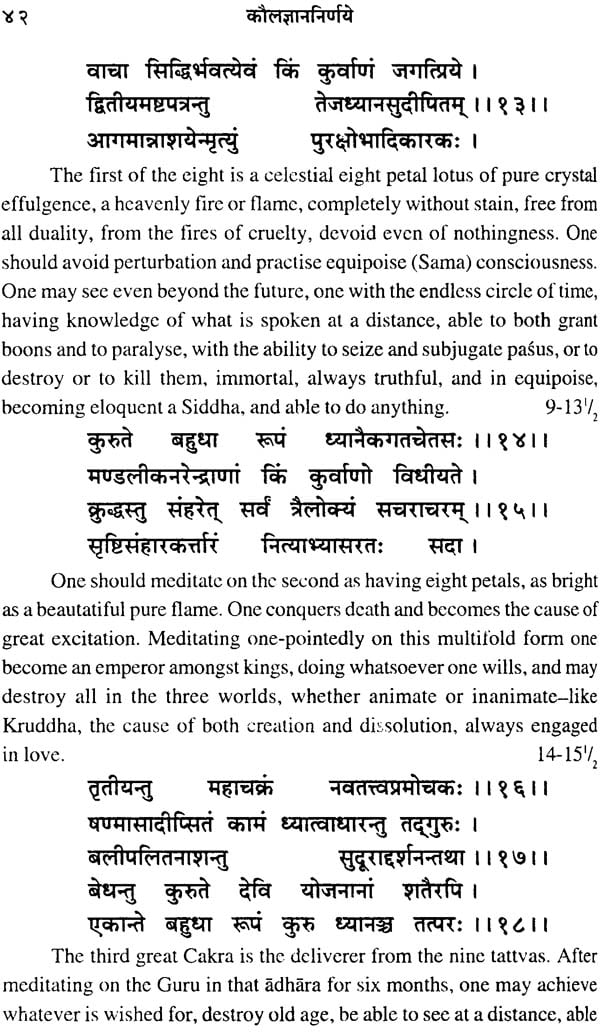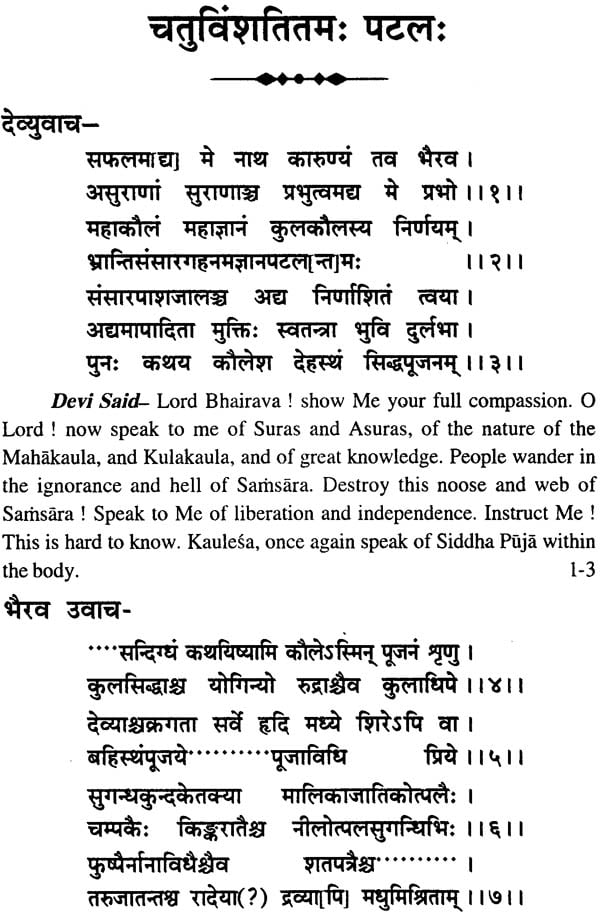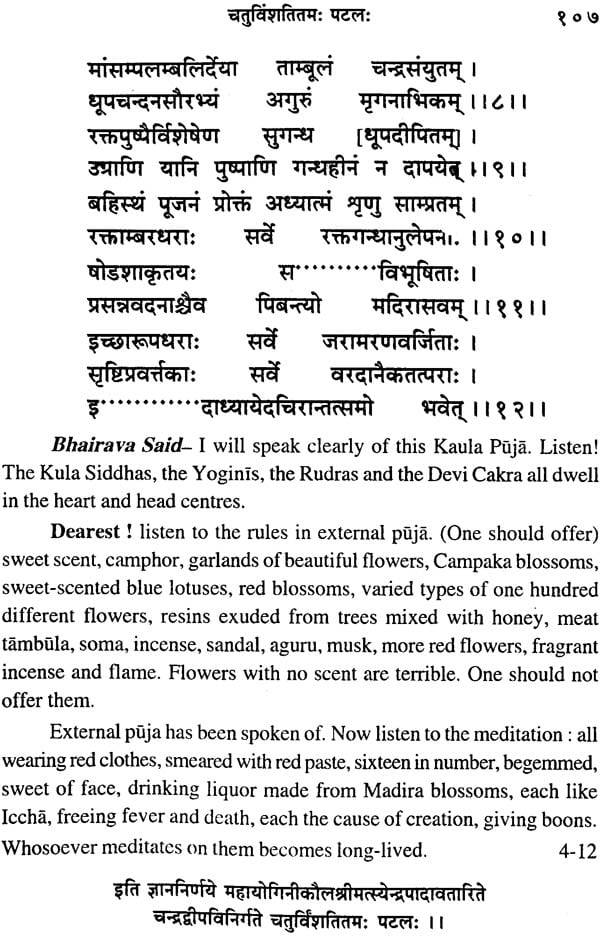
Kaulajnana-Nirnaya of The School Of Matsyendranatha
Book Specification
| Item Code: | IDI656 |
| Author: | P. C. Bagchi, Translated into English by Michael Magee |
| Publisher: | Prachya Prakashan, Varanasi |
| Language: | (Sanskrit Text with English Translation and Exhaustive Introduction) |
| Edition: | 2007 |
| Pages: | 149 |
| Cover: | Hardcover |
| Other Details | 8.7"X 5.3 |
| Weight | 260 gm |
Book Description
As well as having great importance in delineating major elements of the Nath tradition, the present work shows, most clearly, that the Natha's were closely connected with the foundation of the Kaula Schools. The identity of this work seems complete. As examples may be cited the importance given to Hamsa, the colour ted, the concept of Svecchacara, the triple Saktis-Iccha, Janana and Kriya, and numerous other close similarities.
An important point of emphasis in the Kaulajnananirnaya is the esteem in which the Guru is held. As a realized being, he embodies Siva and can therefore assist others on this path.
The Kaulajnananirnaya is ascribed to Sri Matsyendranath, a Siddha of the Nath Sampradaya, who gives under various colloquial names such as Maccbendrapada, Macchindrapada, Matsyohara and Macchaghna. Over the centuries Matsyendranath and his disciples have become well known throughout India, and many legends are associated with each. This is possibly due to the extensive wanderings of Sadhus connected with the various Panthas.
The Translation of the work presented here is the first in any language and may go a long way towards making the hitherto one of the very important yet obscure Texts accessible to the English speaking community.
36Year old Mr. Michael Magee was for seven years a Co-editor of the International Publication "SOTHIS" which covered the esoteric sciences of both East and West in a comprehensive fashion. In 1976 he began his study of Sanskrit, attending classes AT THE Bharatiya Vidya Bhavan in London and also studied extensively on his own, doing Research at the India Office Library and the School of Oriental and African Studies in London. In 1978 he was initiated by his Gurudeva H. H. Shri Gurudeva Mahendranath, Shambhala Tapowan, Mehmadabad, Gujarat -387130. India, and given the name Lokanath. Beides being the Adiguru of the Adinath subsect of the Nath Sampradaya. H. H. Shri Mahendranath is also the last living Guru of the Uttara Kaula Sampradaya - His Gurudevas in these two Paramparas being Shri Lokanath Avadhuta (HP) and Shri Pagala Baba of Ranchi.
Michael Magee has Translated several famous Tantras in English, out of which we have Published two Tantra, i. e. the Vamakesvarimatam and also the Kaula-jnananirnaya, as Nos. 11 and 12 respectively of Varanasi Tantra Granthamala.
This English translation uses the text Kaulajnananirnaya, published in a Sanskrit edition by P. C. Bagchi (Calcutta Sanskrit Series III, 1934). It is ascribed to Sri Matsyendranath, a Siddha of the Natha Sampradaya, who goes under various colloquial names such as Macchendrapada, Macchindrapada, Matsyodara and Machaghna.
There were many difficulties associated with the translation. There are several lacunae. Of the first chapter we only have the last two Slokas. The Sanskrit itself is of archaic and primitive form, and written in a style very different from later Tantras. For example, mantras are not given in code form, as is usual, but in full.
While many of the different subsects of the Nath community were, or are Gorakhnathis, regarding the Siddha Gorakhnath as their founder and Adiguru, a few of the panths regarded Matsyendranath as the more important figure. My own sampradaya, the Adinath subsect, seems to hold this view. A Gorakhnathi's ear cartilage is pierced at initiation, and heavy mudras-clay or wooden rings-inserted. The Adinaths never followed this custom.
Matsyendranath was the Guru of Gorkhnath. As often happens in India, guru figures become transformed over a period of time into gods. In Nepal, even today, Matsya period of time into gods. In Nepal, even today, Matsyendranath and Gorakhnath are worshipped for favour and so forth. A recent Nepalese postage stamp illustrates the Macchendra Ratha, or ritual chariot of the Siddha. The current Nepalese one rupee coin is adorned with a Yantra. And inscribed with the name of Gorakhnath.
As well as having great importance in delineating major elements of the Nath tradition, the present work shows most clearly, that the Nathas were closely connected with the foundation of the Kaula schools. The identity the importance given to Hamsa, the colour red the concept of svecchacara, the triple Saktis - Iccha, Jnana and Kriya, and numerous other close similarities.
An important point oft emphasized in the Kaulajnana-nirnaya is the esteem in which the Guru is held. As a realized Being, he embodies Siva, and can therefore assist other on this path.
The date of this MS is thought by Bagchi to be no later than the 11th century. However Abhinavagupta, the famous sage of Kashmir Saivism, paid homage to Matsyendranath in his massive work Tantraloka. There are many points of agreement between the schools of Kashmir Saivism and the current text.
Matsyendranath is also associated with the Tibetan Vajrayana tradition. Here we have a very important text, seemingly harking back to a time before various view points gained distinct status.
Over the centuries Matsyendranath and his disciples have become well-known throughout India, and many legends are associated with each. This is possibly due to the extensive wanderings of sadhus connected with the various panths.
Of singular interest in the present text is the scant attention paid to Kundalini. Various Cakras are often described in the different patalas, and whilst some of these seem to be identical with the well-known six Cakras, there are also many differences. Matsyendranath seems to be propounding the views of a section of the Kaulas known as the Yoginikaula school. A preference for the 64 Yoginis is obvious, and the Cakra system seems to be based on this Classification.
In the Akulavira Tantra, also ascribed to Matsyendranath, the following verse appears: In Kaula there are two paths, the artificial and the spontaneous (Sahaja). The artificial is Kundali, whilst Sahaja is situated in Samarasa. (Akulavira Tantra, v. 56).
Samarasa is a difficult word to translate into English. In the Natha schools the Sun was the type of Siva, and the Moon of Sakti. Samarasa is the perfect assimilation of Sun and Moon, Siva and Sakti.
This work stresses the importance of Hamsa. This Hamsa is the Ajapa Mantra, uttered spontaneously 24 hours a day by all living creatures. Ha is Siva and Sa is Sakti. These are called Sun and Moon breaths, and there are said to be 21600 of them in day and night. They represent the physiological and psychic Sun and Moon, and one who has achieved their equilibrium (Sama) is a Paramahamsa (above Hamsa). Many sections in this work explain the significance further, and it should be pointed out that the code-word Sahaja (spontaneous) made up from the letters Sa, Ha and Ja may mean 'born from Sa and Ha'.
As a guide to the practical philosophy of the Nath schools, and to help the reader unfamiliar with the tenets, the following summary may be of interest.
The Siva is without parts, stainless, all-pervading., beyond time and space, limitless, endless, one's true being, awareness, consciousness, bliss. This witness manifests by three Saktis which are one with Siva. When these three are assembled or brought together, one attains to Samarasa.
From the three Saktis are born the clusters and clans of other Saktis and time-space factors. These are multifold. Examples might be the five senses, the power to breathe, the power to think &c. Because of Her multifold nature. Sakti is called Maya, as Her intrinsic nature seems to be lost in multiplicity.
As Siva is witness, 'He' is incapable of action save through the Saktis which are one with 'Him'. There is no Siva without Sakti, or Sakti without Siva.
The three Saktis are the letters of the well-known mantra Om (a+u+m). They are also the Saktis of the three gunas, Sattvas, Rajas and Tamas. In a diagrammatical form, they are symbolized by a downward pointing triangle.
Lesser Saktis come into being as a result of the blending of the three in different yet patterned proportions. Saktis are called Kulas, or clans, as they cluster together. Siva is called Akula, as 'He' has no qualities or clusters. A Kaula is a knower of both Kula and Akula, on a spiritual path of return in distinction to the outward current of ordinary life.
This text makes frequent reference to Kamarupa, in present day Assam. This place has mythic significance for Kaulas, as it is said to be the spot where the Yoni of Sakti fell after Her body was cut into pieces by Visnu's discus. However the Natha and Kaula symbolism is often hard to interpret. A cremation may be interpreted as the place of unity of exhalation and inhalation-where all desires are burnt up, and the crossroads as the concourse of the four elements. Wine is often taken as a symbol for Sahaja Ananda, or spontaneous bliss.
If there are any defects in the translation, due to my own mistakes or the elliptical nature of the text, I Would ask the forgiveness of the reader in view of the particular practical importance of this work.
Some word of explanation are necessary for releasing these texts for publication. The texts, as will be seen at once, were in a sad state. They are full of corrupt readings so much so that it is very often impossible to make out any sense. I could not get other manuscripts for collation and this is why it has been impossible for me to establish the correct readings. I have refrained from any corrections except in a few cases of palpable confusion of the copyists. It may be asked why I have been so anxious to publish the texts inspite of such difficulties. My only explanation is that they are associated with a teacher and a school, still little known, though they play the most important role in the history of medieval Indian mysticism. I think that the present texts inspite of their defects will be helpful in the study of the history and doctrines of that school.
As regards the language of these texts I do not, however, believe that it was ever completely satisfactory from a strict grammatical point of view. We are familiar with such a curious language from the Buddhist Tantras and it seems that the same tradition was followed by writers of the school of Matsyendranatha. The motive probably was to write a kind of Sanskrit which would be accessible to all initiates even without any preparation in grammar. The Buddhist writers of later age publicly declared such a policy. See the Vimalaprabha, the Commentary on the Kalacakra- Tantra quoted by H.P. Sastri in his Descriptive Catalogue of the Sanskrit Manuscripts in the Government Collection, A.S.B. p. 78.
[In order to ruin the practice of using literary words current amongst those who stand for the use of literary words, vulgar words have been used in certain sentences but keeping an eye on the meaning. In other sentences sometimes punctuation has been neglected, words used without any inflexion, the accentuation misused, long used for short and short for long, the seventh case used for the fifth and the sixth for the fourth, the Atmanepada roots conjugated in Parasmaipada and vice versa, the plural used for the singular and singular for the plural, neuter gender for the masculine and masculine for the neuter, dental and cerebral sibilants used for the palatal, palatal and dental for the cerebral, and palatal and cerebral for the dental. And such other practices also should be followed in accordance with the instructions of preachers of theTantras.]
It seems that this tradition, though Buddhistic, has been followed in the composition of the present texts. There is nothing unexpected in it. I have tried to show in details in my Introduction that in the present texts there is a medley of doctrines which can be partly traced in the Brahmanical and partly in the Buddhist Tantras. They represent a system which clearly deviates from the orthodox Brahmanical mysticism.
I have not been able to say much about the definite contribution of Matsyendranatha to medieval mysticism. Tradition claims him to be the first teacher of Hathayoga after Adinatha i.e. Siva. It is difficult to say at present if the entire system or only a few of its methods had been invented by him. Some of the asanas and mudras in the Hathayoga are, however, expressly associated with his name e.g. Matsyenrasanam, Matsyenrana- thabhimatam padmasanam etc. I have tried to prove that other elements of this yoga can be also discovered in our texts. Moreover an entire verse of the Kaulajnananirnaya is found in the Hathayogapradipika almost in the same form.
Under these eircumstances it may be held that there is some truth in the trandition which associates Hathayoga with Matsyendra.
I have not said anything about the state of preservation of the Kaulajnananiraya. In the colophon of the text (p. 83) it is said that the text consists of 1000 verses (namna sahasrikam matam). Taking into consideration the portion of the first chapter which has been lost and calculating according to the Neapalese way (in which 32 letters of any prose portion also are equivalent to averse) my estimate goes up to about 800 verses. It, therefore, seems that the text has suffered damage in other places too which can not be ascertained.
In giving the abstracts of the texts I have tried to draw the attention of the readers only to the main ideas contained in each of the chapters. In this I may be sometimes misled by the queer constructions, and by technical terms many of which are not yet clear to me. I have left aside altogether the study of the mantras.
My thanks are due to the learned editor of the Series, my friend and colleague, Dr. Amareswar Thakur, M.A., Ph.D., who has readily included the present work in his Series. I should like to acknowledge my indebtedness also to Panit Narendra Chandra Bhattacharya. M.A., who has helped me in the correction of the proofs.
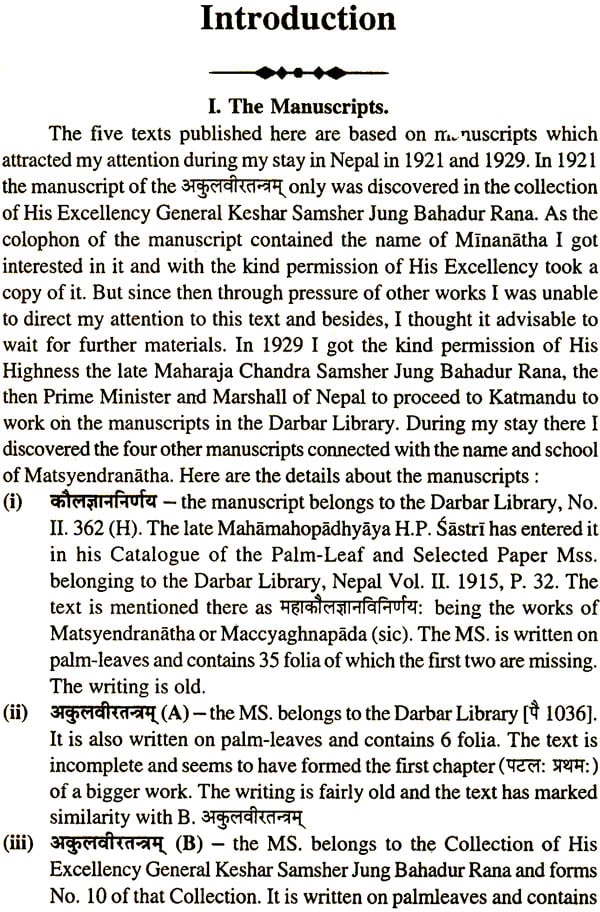
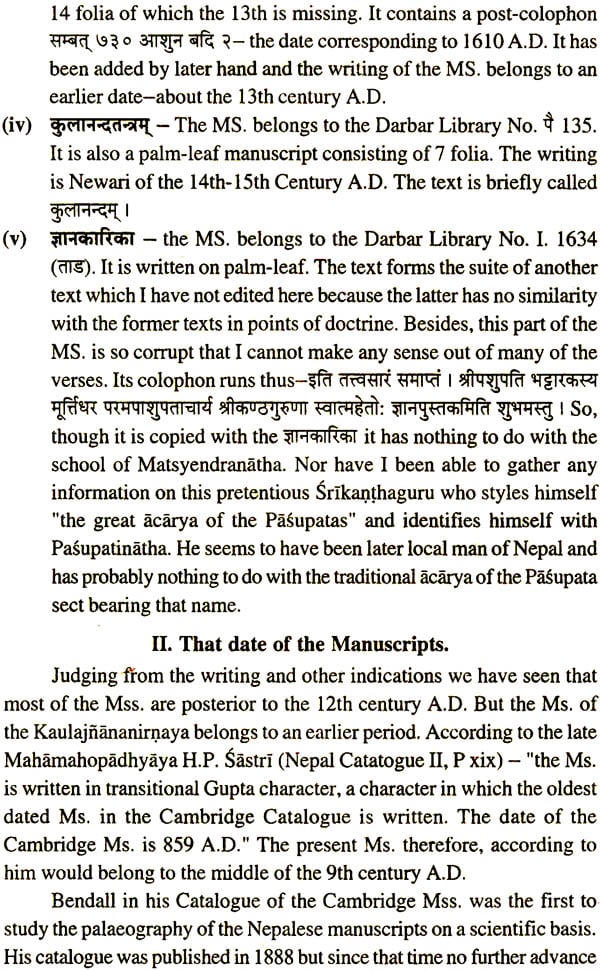
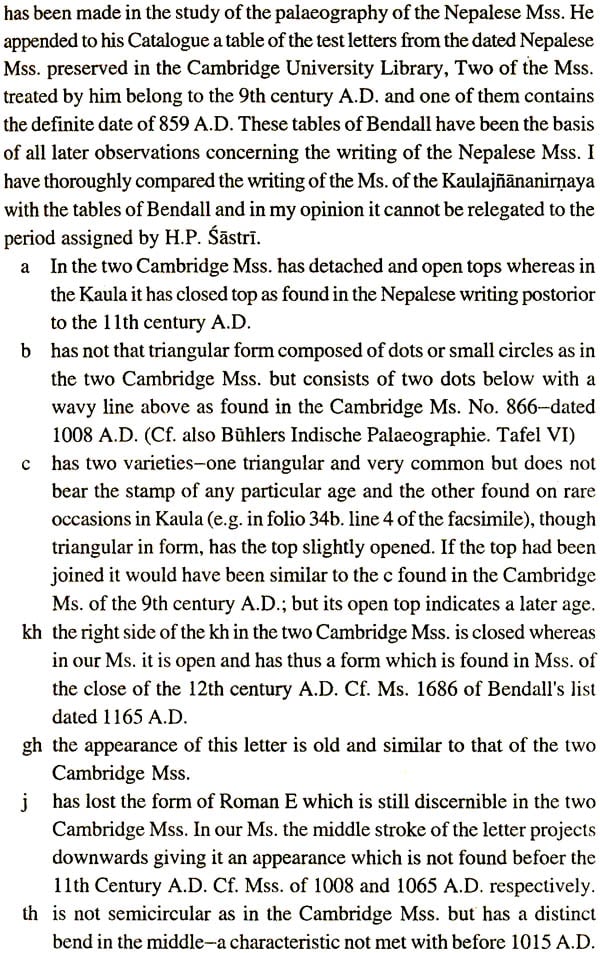
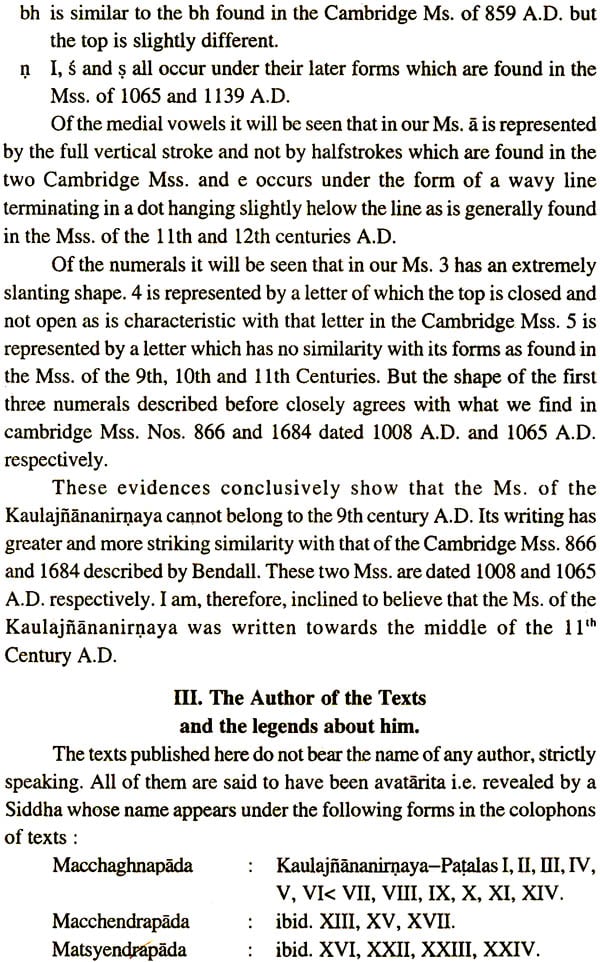
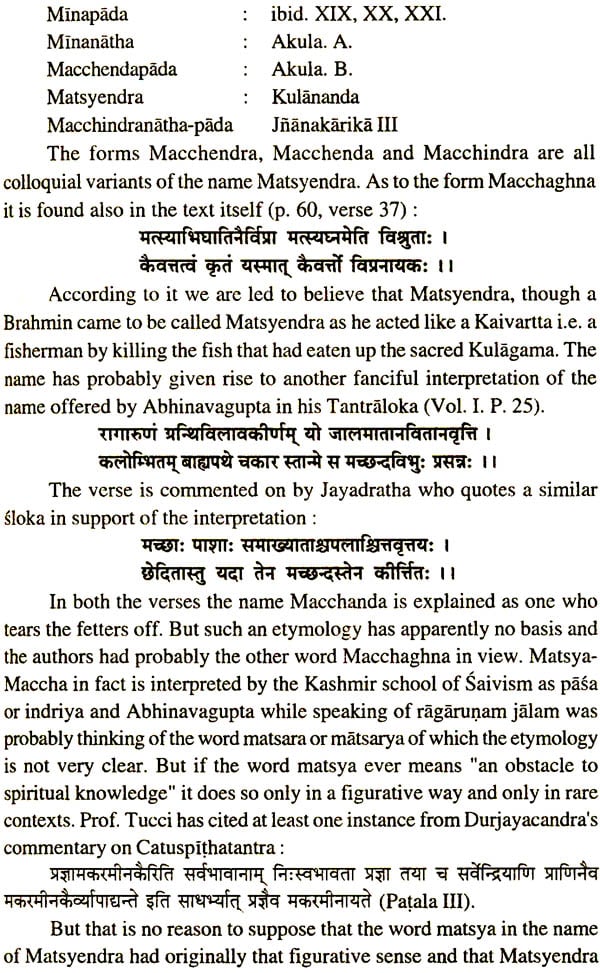
| Preface by the Translator | vii |
| Preface by the Editor of the Text | xiii |
| Introduction | 1-69 |
| The Manuscript 1, The Date of the manuscript 2, The author of | |
| the Text and legends about him 4, The Tradition 16, The time and | |
| place of origin 20, The School and its fundamental doctrines 27, The | |
| Yoginl kaulas of Matsyendranath and the Buddhist Tantras 46 | |
| Notices on Mss. relating to Matsyendranath | 51 |
| Abstract of the Text | 61 |
| The Text : Kaulanana nirnaya | 1-108 |
| 1 On Creation 1. 2 On Destruction 2. 3 On the characteristics of | |
| Kula 4. 4 On difrerent Yogic powers 9. 5 On dissipation of en-or 13. | |
| 6 On the characteristics of Jiva 19. 7 On how old age and death can | |
| be stopped 23. 8 On the worship of Saktis and Guru 28.9 On the Guru | |
| and Siddhas 37. 10 On the Cakras 40. 11 On the characteristics of | |
| Caruk 45. 12 On the characteristics of Carya and Patras 51. 13 On | |
| Moksa and Nyasa 54. 14 On Dhyana-yoga-mudra 56. 15 Param- | |
| vajrlkarana 71. 16 On Avataras of Bhairava 75. 17 On the | |
| determination of the Atman 84. 18 On the Kula-dvipa-vidhanam 90. | |
| 19 On the lotus within the body 94. 20 On the Jnanasakti and | |
| Kriyasakti 95. 21 On the different Kaula schools 99. 22 On the | |
| Yogini-kaula 106. 23 On the forms assumed by the Yoginis on earth | |
| 103 24 On the worship of the Siddhas within the body 106. |
